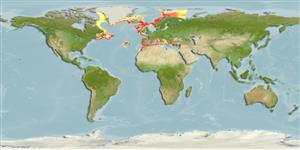Environment: milieu / climate zone / depth range / distribution range
Ecology
Marine; demersal; non-migratory; depth range 150 - 1000 m (Ref. 54594), usually 350 - 500 m (Ref. 54594). Temperate; 79°N - 29°N, 65°W - 44°E (Ref. 54594)
Northeast Atlantic: Southwestern Barents Sea, sometimes north to Spitsbergen, southeastern Greenland, southern coast of Iceland, around the British Isles and south to Morocco and into the western Mediterranean. Northwest Atlantic: Newfoundland.
Length at first maturity / Size / Weight / Age
Maturity: Lm 86.5 range ? - 88 cm
Max length : 155 cm TL male/unsexed; (Ref. 1371); max. published weight: 30.0 kg (Ref. 35388); max. reported age: 20 years (Ref. 1371)
Dorsal
spines
(total): 0;
Anal
spines: 0;
Anal
soft rays: 70 - 81. Lower jaw longer than upper jaw; barbel shorter than eye diameter. Back gray-brown, grading to white ventrally. Posterior portions of vertical fins dark with pale margins.
Found mostly from 350-500 m depth on muddy bottoms. Feed on crustaceans and fish (flatfishes, gobies, rocklings) (Ref. 1371).
Cohen, D.M., T. Inada, T. Iwamoto and N. Scialabba, 1990. FAO species catalogue. Vol. 10. Gadiform fishes of the world (Order Gadiformes). An annotated and illustrated catalogue of cods, hakes, grenadiers and other gadiform fishes known to date. FAO Fish. Synop. 125(10). Rome: FAO. 442 p. (Ref. 1371)
IUCN Red List Status (Ref. 130435)
Threat to humans
Harmless
Human uses
Fisheries: commercial
More information
ReferencesAquacultureAquaculture profileStrainsGeneticsElectrophoresesHeritabilityDiseasesProcessingNutrientsMass conversion
Tools
Special reports
Download XML
Internet sources
Estimates based on models
Preferred temperature (Ref.
123201): 2.1 - 14.1, mean 6.3 °C (based on 199 cells).
Phylogenetic diversity index (Ref.
82804): PD
50 = 0.6250 [Uniqueness, from 0.5 = low to 2.0 = high].
Bayesian length-weight: a=0.00302 (0.00169 - 0.00538), b=3.03 (2.87 - 3.19), in cm total length, based on LWR estimates for this species & (Sub)family-body (Ref.
93245).
Trophic level (Ref.
69278): 4.5 ±0.6 se; based on diet studies.
Resilience (Ref.
120179): Low, minimum population doubling time 4.5 - 14 years (K=0.13-0.16; tm=8-11; tmax=20).
Prior r = 0.35, 95% CL = 0.23 - 0.52, Based on 4 stock assessments.
Fishing Vulnerability (Ref.
59153): Very high vulnerability (75 of 100).
Climate Vulnerability (Ref.
125649): Moderate to high vulnerability (47 of 100).
Nutrients (Ref.
124155): Calcium = 16.4 [8.1, 35.6] mg/100g; Iron = 0.278 [0.142, 0.592] mg/100g; Protein = 17.6 [15.8, 19.3] %; Omega3 = 0.381 [0.204, 0.707] g/100g; Selenium = 29.8 [15.2, 59.6] μg/100g; VitaminA = 10.9 [2.7, 40.8] μg/100g; Zinc = 0.305 [0.198, 0.473] mg/100g (wet weight);
